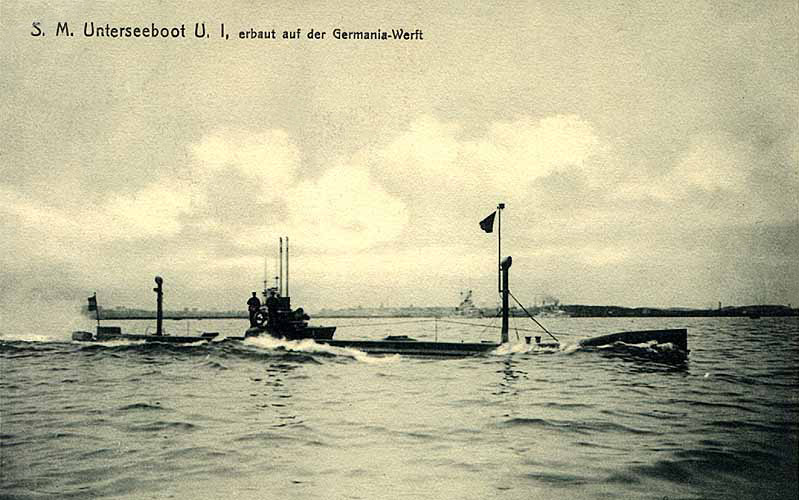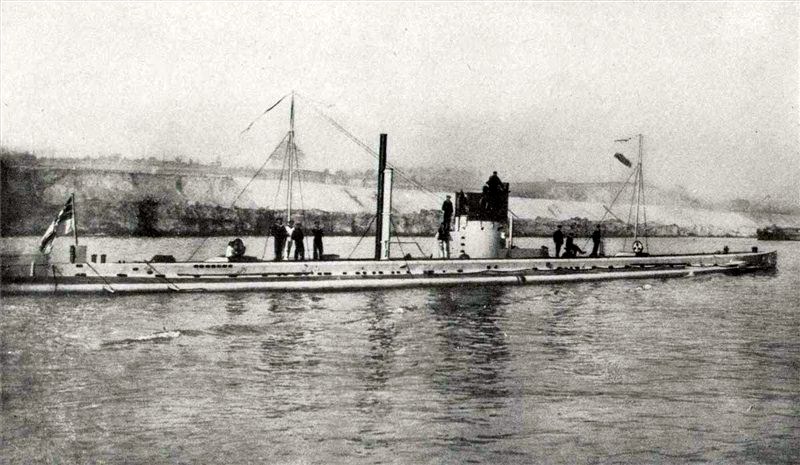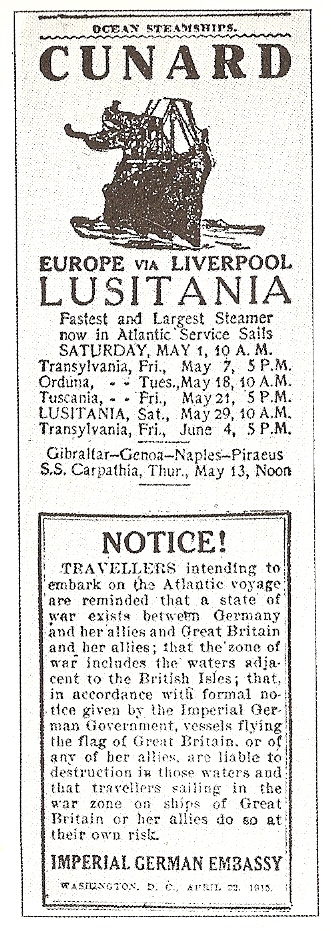Brief History of the Submarine
In 1620, Cornelius DrebbelDuring the 18th century, the Turtle was designed by David Bushnell which held one person. It was the first submarine capable of independent movement and the first to use screws for propulsion. During the American Revolutionary War, Turtle (operated by Sgt. Ezra Lee, Continental Army) tried and failed to sink the British warship HMS Eagle, flagship of the blockaders in New York harbor on September 7, 1776.
On August 4, 1906, the first German U-boat, Unterseeboot-eins, was launched at Danzig. The world’s superpowers had no idea, and honestly, were not concerned with the introduction of the new German submarine. World War I would be the first time the fleet of U-boats
Check out Submarine History for an extensive history of the Submarine from 1580 on.
The Evolution of the German U-boat Fleet
Great Britain may have paved the way for industrialism during the first revolution, however after 1870; Germany was swiftly replacing Great Britain as the Industrial leader in Europe.
Since the industrial plant had already been established in Great Britain, it was difficult to transition to new techniques and machinery. The Germans, however, built the latest and most efficient manufacturing plants. Since Britain was notoriously suspicious of any new innovations in industry, they chose not to invest in the latest machinery, thus they suffered economically in that aspect. The German industrialists were accustomed to change, so acquiring more capital from banks for expansion was never a concern. Furthermore, German industry was aided by professionals in science and technology who consistently worked with firms to produce the latest in inventions for efficient and economically productive products.~ The Second Industrial Revolution During the 19th Century
Germany saw a need to protect her small coast, especially after gaining new overseas colonies. Trading ships that transported raw materials and industrial goods needed to be protected on the world seas. At the end of the 19th century, William II of Germany recognized the need to cooperate with industrialists, especially considering Germany’s industry rivaled that of England.
At the beginning of the 20th century, the German Navy, although not as large as England’s, had become a bit dangerous in nature. England became aware of this fact, considering its fleets were always as large, if not larger, that the three largest naval powers in Europe combined. Europe immediately started to increase its navy, however in 1905 Grand Admiral Alfred von Tirpitz started working on defensive and offensive submarines.
German industrialist Gustav Krupp
With his own money, Krupp funded the entire plan, thus several features of the submarines were dismissed when funding ran out. The first prototype was introduced on June 8, 1903 and measured 13 meters long and traveled 40 nautical km at a surface speed of 4 knots. Submerged, the vessel traveled at 5.6 knots. The first test in 1904 impressed William II, however Kaiser Tirpitz
Interestingly enough, the first submarine was sold to the Russians in 1904 for the Russo-Japanese War, along with three other vessels of the same design-called the Karp Class. The original design was improved once Krupp's engineers started building them for the Russians. In 1905, Tirpitz finally agreed to purchase submarines for the Germany fleet at the price of 1.5 million marks.
The Launching of the German U-boat U-1
The first U-boat, the U-1, launched in 1906. The boat measured close to 140 feet long, weighed 238 tons, and could carry 20 men. U-1 was armed with a 46 cm bow torpedo tube with three self-propelled torpedoes and an 88 mm deck gun. The U-1 could reach maximum speeds of 10.8 knots on the surface and 8.7 knots while submerged. The cruising range, measuring 2,414 km, made the new U-1 U-boat an important new weapon for Germany.“Testing of the U-1 resulted in a collision while on a training exercise in 1919. The U-1 was sold to the Germaniawerft foundation at the Deutsches Museum in Munich where it was restored and can be viewed on display.”
World Power Opinions of the U-boat Fleet
German U-boat U-1
Image Via Wikipedia SM U-1The introduction of the German U-1 was hardly a reason for the largest navies in the world to be alarmed. The Germans had entered the waters a bit too late, especially if they wanted to rival the numbers of vessels in the fleets of the great world powers. At the time, France had 123 submarines, England had 72, Russia had 41, United States had 34, and Germany had 26. This would prove to be a minute issue for the Germans as their fleet continued to grow.
The German U-boat Fleet Commands the Seas
German U-boat U-9
Image Via Wikipedia SM U-9
On September 22, 1914, commander of the U-9 Captain Otto Weddigen, sank three English vessels in less than an hour. England relied heavily on commercial trade, so the sinking of their commercial fleet led to a shortage of essentials that couldn’t reach them. England’s surface waters were now open to German U-boat attacks, and this was an admission the admiralty of England could not ignore.
German U-boat U-17
October 14, 1914, Lietenant Captain Feldkirchner, commander of the U-17, sunk the English steamer, the SS Glitra off the Norwegian coast. In 1907, an agreement at Geneva outlawed surprise attacks on civilian steam ships, however Germany blockaded the British Isles and started sinking commercial vessels. U-17 was decommissioned on 27 January 1919 and sold for scrapping.
German U-boat Attacks RMS Lusitania
The Lusitania, carrying war supplies for the war effort, had already been warned prior to its final voyage. In fact, the German embassy posted a full page advertisement in the New York Times, warning Americans that German U-boats would be in the water and may attack due to the wartime cargo aboard the ship. Against warnings, the Lusitania sailed. On May 7, 1915, the Lusitania was torpedoed by the German U-boat U-20 under the command of KL Walther Schwieger, , killing close to 1200 people, 124 of which were Americans. Rumors serviced that blamed German U-boats for the second explosion, after the Lusitania was already sinking. Further investigations, however, proved that the explosion was due to the ammunition aboard Lusitania.
Public outcry and protest by the Americans forced Germany to stop attacks on civilian ships
Image via Wikipedia RMS Lusitania
The Consequences of the German U-boat Fleet
Fearing the Americans would enter the war, Germany grew desperate. General Erich Ludendorff and Field Marshal Paul von Hindenburg set up a blockade, to render England helpless before America could intervene. Three vessels were sunk forcing President Woodrow Wilson to ask Congress to formally declare war on Germany. This concreted Germany’s defeat in the war.The ending result and consequence of the launching of the first U-1 set the ground for a major conflict between America and Germany, prior to World War II.
Video Of German U-boat 1940
This German propaganda movie was part of a U.S. Navy archive compiled during WWII, and acquired by Periscope Film. In this film, a German U-boat is shown being resupplied at sea by a Type XIV milkcow submarine. Torpedoes and food are transferred, along with diesel fuel. The U-boat then resumes its hunt for English merchant ships during the Battle of the Atlantic.
Note: Video is in German, however the footage is fascinating, even if you can't understand the language.
(1) "With the downfall of Germany, members of her underseas flet rise to the survace and on radio instructions from Berlin, procede to surrender to Allied naval authorities. The U-358 rides into Cape May, N.J., in the custody of a destroyer escort 'prize' crew. At Portsmouth, N.H., destroyer escorts convoy the U-805 into harbor. The Nazi crew is brought ashore still surly and impudent, only to be whisked off to Portsmouth Naval Prison. Back in ruined Bremen, British tommies discover pre-fabricated sections of submarines, parts of an assembly plan which was calculated to add hundreds of new subs to the German navy." scenes of ruins of Bremen sub shipyard, U-boat prisoners arrive in US., in Portsmouth, arogant captain unrepenitent.(2) Germans Surrender Among Ruins - "Berlin: Air Marshal Tedder, General Spaatz, Marshal Zhukoff and others receive the surrender of General Keitel, Admiral Friedberg and General Stumpf, which commits Nazi Germany to Allied control, ceases hostilities and ratifies the previous capitulations to General Eisenhower and General Montgomery. The Wreckage of Germany - R.A.F. saturation bombings of Hamburg have destroyed the huge ship yards and left all buildings absolutely gutted. Hamburg is ruined. And the question 'What of Berlin?' is now answered. All Nazi government buildings are totally ruined, as are the famous hotels and other buildings which lined her famous boulevards." scenes of Keitl surrenders to Zhukov in Berlin, Russians tour the gutted capital, pictures of destroyed Hamburg; (3) German Loot Discovered - "Reichsbank Cache - Yanks entering the world's largest salt mines at Merkers, Germany are startled to find one hundred tons of gold bullion, jewels, silver currency and priceless paintings by the masters, the cached loot of the Nazis." (4) In The Wake Of Victory - "Eminent people, long held in Nazi prison camps are found at a Villa in the Alps. They include Baroness Schussning, Fritz Thyssen, industrialist, Prince Leopold of Prussia, Anti-Nazi Pastor Niemacher, Lt. John Winant and Lord Lascelles, nephew of King George VI. In contrast at Magebarg, General Dietmars, Nazi broadcaster becomes a prisoner of the Yanks." (5) All Out Air War On Japan - "Aircraft factories near Nagasaki are bombed by B-29s from Guam. From Saipan, a fleet of B-29s pierce clouds of flak over Tokyo to plant tons of bombs on the Jap capital city. Homeward, many of the Superforts are forced down at Iwo Jima, where flak damage is seen to be severe." scenes of map and arial footage of airstrikes on Japan, damaged SuperFortress lands on Iwo Jima. (complete newsreel)
What Happened to The U-boats After World War II? Read Part Two @AncientDigger
Planes used during World War I
Although Kitty Hawk
Read More: Planes used during World War I
The White Star Line was a British shipping company most famous for its ill fated flag ship the RMS Titanic and World War I sister ship, Britannic.
The White Star Line was originally founded in Liverpool in 1845 by John Pilkington and Henry Wilson. The company's initial focus was on the Australian gold mine trade. In the early 1850's if you had sound ships and ran the Australian route, it would almost be difficult to not succeed. In one month of 1853, no less than 32,000 "get rich quick" hopefuls left port in Liverpool bound or Australia to strike their fortunes in gold. Archived Photography of the White Star Line and Her Ships
 She hit an iceberg and sank, in one of the most epic tragedies of all time. Nearly 100 years later tales of the RMS Titanic remains legendary. Perhaps the work of James Cameron and Leo Di Caprio can be credited for bringing the story of this ill-fated trip to mainstream popular culture. Or perhaps, even without a multi-billion dollar blockbuster our morbid human curiosities would still keep us entranced by this sunken piece of history. Diving the Titanic in Newfoundland
She hit an iceberg and sank, in one of the most epic tragedies of all time. Nearly 100 years later tales of the RMS Titanic remains legendary. Perhaps the work of James Cameron and Leo Di Caprio can be credited for bringing the story of this ill-fated trip to mainstream popular culture. Or perhaps, even without a multi-billion dollar blockbuster our morbid human curiosities would still keep us entranced by this sunken piece of history. Diving the Titanic in Newfoundland In both cases of Fascist Italy and Nazi Germany, the world war had created high unemployment and dissatisfied veterans. Fascism grew in Italy just as swiftly as Nazism in Germany out of extreme rightist preoccupations with nationalism and, in the case of Germany, racism. One aspect that differed between Fascism and Nazism was the extreme terror put forth by the Nazis against the Jews, however not so much lacking in Fascist Italy. In any case, the condition of the governments at the time made them easy targets for takeover, therefore allowing a new party to emerge that consisted of violent groups, thus ending in superior races that would wreak havoc on society.The Differences and Similarities of Fascism and Nazism
In both cases of Fascist Italy and Nazi Germany, the world war had created high unemployment and dissatisfied veterans. Fascism grew in Italy just as swiftly as Nazism in Germany out of extreme rightist preoccupations with nationalism and, in the case of Germany, racism. One aspect that differed between Fascism and Nazism was the extreme terror put forth by the Nazis against the Jews, however not so much lacking in Fascist Italy. In any case, the condition of the governments at the time made them easy targets for takeover, therefore allowing a new party to emerge that consisted of violent groups, thus ending in superior races that would wreak havoc on society.The Differences and Similarities of Fascism and NazismPictures under Evolution of the German U-boat Fleet are screen captures from 1940 video of U-boat being refueled and replenished.
Madden, Paul. "Germany Launches Forst U-boat." Great Events. Print.
The Second Industrial Revolution During the 19th Century
Dutch Submarines















0 Comments:
Post a Comment
We appreciate comments, but we delete SPAM.